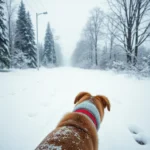
Introduction
Socialization is a critical aspect of a dog’s overall health and well-being. It helps them develop the necessary skills to interact positively with people, other animals, and various environments. For neglected dogs, the journey to socialization can pose unique challenges due to their past experiences. These dogs may have been deprived of the social interactions that are vital for their emotional and mental development, leading to behavioral issues such as fear, anxiety, or aggression.
Understanding how to socialize a neglected dog is essential for their rehabilitation and integration into family life. This article will delve into the complexities of neglect, the importance of socialization, and a step-by-step guide to help both the dog and the owner navigate this essential process.
Understanding Neglect in Dogs
What is Neglect?
Neglect in dog care refers to the failure of an owner to provide necessary care, including adequate food, shelter, veterinary attention, and social interaction. Common signs of neglect include:
- Malnutrition: Underweight or emaciated appearance due to lack of proper nutrition.
- Lack of Shelter: Exposure to harsh weather conditions without appropriate protection.
- Poor Hygiene: Mats in fur, untreated injuries, or dental problems can indicate neglect.
Recognizing these signs is the first step toward understanding the needs of a neglected dog and addressing their socialization challenges.
The Impact of Neglect on a Dog’s Behavior
The consequences of neglect are profound and can significantly affect a dog’s mental and emotional health. Neglected dogs may exhibit:
- Fear: Due to past trauma, these dogs might react fearfully to new situations or people.
- Aggression: A neglected dog may develop aggressive tendencies as a defense mechanism.
- Anxiety: Separation anxiety or general anxiety can be common in dogs that have experienced neglect.
Understanding these behavioral issues is crucial for developing effective socialization strategies.
The Importance of Socialization
What is Socialization?
Socialization is the process of exposing a dog to various stimuli, including people, animals, environments, and experiences, to help them learn how to navigate the world confidently. For puppies, this critical socialization period occurs between three and fourteen weeks of age. However, neglected dogs, regardless of age, can still benefit from socialization.
Benefits of Socialization
Proper socialization contributes to a dog’s overall health and happiness. Benefits include:
- Improved Behavior: Well-socialized dogs are generally more adaptable and less likely to exhibit fear or aggression.
- Enhanced Mental Health: Exposure to various stimuli can help reduce anxiety and promote confidence.
- Better Relationships: Socialization fosters positive interactions with humans and other dogs, leading to a more harmonious home environment.
Preparing to Socialize a Neglected Dog
Assessing Your Dog’s Behavior
Before diving into socialization, it’s essential to assess your dog’s current behavior. Pay attention to:
- Body Language: Look for signs of fear or aggression, such as cowering, growling, or raised hackles.
- Triggers: Identify specific situations or stimuli that cause fear or anxiety, such as loud noises or the presence of other pets.
- Comfort Zones: Determine what makes your dog feel secure, such as a favorite spot or toy.
Understanding these factors will inform your approach to socialization.
Creating a Safe Environment
Establish a controlled and safe space for initial socialization efforts. Consider the following:
- Fenced Area: Choose an enclosed area where your dog can explore without the risk of running away.
- Leashes and Harnesses: Use a well-fitted leash and harness to maintain control during interactions.
- Crates: A crate can provide a safe space for your dog to retreat if they feel overwhelmed.
Setting up this environment helps your dog feel secure and ready to engage with new experiences.
Step-by-Step Guide to Socializing a Neglected Dog
Building Trust
Building trust is the foundation of socializing a neglected dog. Here are some techniques:
- Gentle Handling: Approach your dog calmly and gently, avoiding sudden movements.
- Positive Reinforcement: Use treats and praise to reward your dog for calm behavior and small victories.
- Patience and Consistency: Be patient; building trust takes time. Consistency in your approach will foster security.
Gradual Exposure to New Experiences
Start introducing your dog to new experiences gradually. Follow these steps:
- Familiar Settings: Begin in a familiar environment, like your backyard or living room, to ease your dog into new experiences.
- Controlled Introductions: Introduce your dog to one calm person or pet at a time. Observe their reactions and give them time to adjust.
- Increase Complexity: As your dog becomes more comfortable, gradually introduce new environments, such as a friend’s house or a quiet park.
This step-by-step approach helps prevent overwhelming your dog and encourages positive associations.
Engaging in Positive Interactions
Encourage positive interactions through various activities:
- Playdates: Arrange playdates with well-mannered dogs to promote social skills.
- Training Classes: Enroll in basic obedience or socialization classes designed for sensitive dogs.
- Treats and Praise: Use treats to reward positive interactions and reinforce good behavior during socialization efforts.
These interactions enrich your dog’s social experiences and contribute to their overall well-being.
Overcoming Challenges
Dealing with Fear and Anxiety
Managing fear and anxiety during socialization is vital. Consider these strategies:
- Recognize Signs of Stress: Look for signs such as panting, hiding, or excessive barking. If your dog shows these signs, it may be time to take a step back.
- Gradual Desensitization: Slowly introduce your dog to the source of their fear. For instance, if your dog is afraid of strangers, start by having a calm friend stand at a distance before gradually moving closer.
- Calm Environment: Use calming aids such as pheromone diffusers or anxiety wraps to create a tranquil atmosphere.
Understanding and managing your dog’s fear can facilitate more effective socialization.
Handling Aggression
If your neglected dog displays aggressive behavior, it’s crucial to approach this with caution:
- Safety First: Use a muzzle if necessary to prevent biting during training sessions.
- Avoid Confrontation: Do not force interactions; instead, allow your dog to approach on their own terms.
- Seek Professional Help: If aggression persists, consult a professional trainer or behaviorist experienced in working with neglected dogs.
Addressing aggression promptly and safely is essential for successful socialization.
Ongoing Socialization and Maintenance
Continuing Socialization Beyond Initial Training
Socialization is not a one-time event; it requires ongoing effort. Regular activities to consider include:
- Dog Parks: Visit dog parks during quiet times to expose your dog to other dogs in a controlled setting.
- Group Training: Participate in group classes to reinforce skills and provide continued socialization.
- Field Trips: Take your dog on outings to various environments, such as pet-friendly stores or outdoor festivals.
Continued exposure helps maintain and build upon your dog’s social skills.
Monitoring Progress and Adjusting Techniques
Regularly assess your dog’s progress. Look for improvements in behavior and responsiveness to different stimuli. Adjust your techniques based on your dog’s comfort level and progress. If you notice setbacks, it may be beneficial to revisit earlier steps or seek additional support.
Seeking Professional Help
When to Consult a Veterinarian
A veterinarian plays a crucial role in a neglected dog’s behavioral health. Consult your vet if you notice:
- Health Issues: Underlying health problems can affect behavior. Your vet can rule out medical conditions that may contribute to anxiety or aggression.
- Behavioral Concerns: Discuss any persistent behavioral issues to receive guidance on the next steps.
The Role of Professional Trainers and Behaviorists
Working with a professional trainer or behaviorist can be invaluable, especially for neglected dogs. When choosing a professional, look for:
- Experience with Neglected Dogs: Ensure they have specific experience in rehabilitating neglected or fearful dogs.
- Positive Reinforcement Techniques: Choose a trainer who emphasizes humane methods and positive reinforcement.
- References and Reviews: Seek recommendations from other dog owners or shelters to find reputable professionals.
Professional support can provide tailored strategies and insights that can significantly enhance your socialization efforts.
Conclusion
Socializing a neglected dog is a rewarding yet challenging journey that requires patience, understanding, and commitment. Recognizing the signs of neglect and its impact on behavior is crucial for effective intervention. By prioritizing socialization, you can significantly improve your dog’s quality of life and foster a deeper bond.
Remember to take your time, celebrate small victories, and always focus on creating positive experiences. The journey to socializing a neglected dog may be long, but the results can lead to a fulfilled and happy companion.
Every dog deserves a second chance, and with compassion and dedication, you can help your neglected dog thrive in a loving environment.









